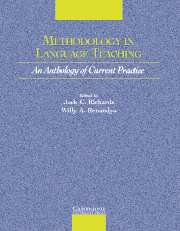Book contents
- Frontmatter
- Contents
- Acknowledgments
- Introduction
- Section I Approaches to Teaching
- Section 2 Lesson Planning and Classroom Management
- Section 3 Classroom Dynamics
- Section 4 Syllabus Design and Instructional Materials
- Section 5 Task and Project Work
- Section 6 Learning Strategies
- Section 7 Teaching Grammar
- Section 8 Teaching Pronunciation
- Section 9 Teaching Speaking
- Section 10 Teaching Listening
- Section 11 Teaching Vocabulary
- Section 12 Teaching Reading
- Chapter 26 Dilemmas for the Development of Second Language Reading Abilities
- Chapter 27 Teaching Strategic Reading
- Chapter 28 Extensive Reading: Why Aren't We All Doing It?
- Section 13 Teaching Writing
- Section 14 Assessment
- Section 15 Technologies in the Classroom
- Section 16 Professional Development
- Credits
- Author Index
- Subject Index
- References
Chapter 26 - Dilemmas for the Development of Second Language Reading Abilities
Published online by Cambridge University Press: 10 November 2010
- Frontmatter
- Contents
- Acknowledgments
- Introduction
- Section I Approaches to Teaching
- Section 2 Lesson Planning and Classroom Management
- Section 3 Classroom Dynamics
- Section 4 Syllabus Design and Instructional Materials
- Section 5 Task and Project Work
- Section 6 Learning Strategies
- Section 7 Teaching Grammar
- Section 8 Teaching Pronunciation
- Section 9 Teaching Speaking
- Section 10 Teaching Listening
- Section 11 Teaching Vocabulary
- Section 12 Teaching Reading
- Chapter 26 Dilemmas for the Development of Second Language Reading Abilities
- Chapter 27 Teaching Strategic Reading
- Chapter 28 Extensive Reading: Why Aren't We All Doing It?
- Section 13 Teaching Writing
- Section 14 Assessment
- Section 15 Technologies in the Classroom
- Section 16 Professional Development
- Credits
- Author Index
- Subject Index
- References
Summary
INTRODUCTION
Since the 1980s, a number of advances have been made in research on reading, both in first and second language contexts. Although the advances in first language contexts have led to a number of improvements in reading instruction, the corresponding research in second language contexts has not made as much headway. The reasons for these differences will be discussed in the form of dilemmas for second language reading instruction. By way of introduction to these dilemmas, research findings that have influenced L1 reading instruction are briefly reviewed, and the corresponding advances in second language research are noted. The larger discussion will then focus on the dilemmas that second language contexts impose on reading instruction and the possible responses to these dilemmas.
FIRST LANGUAGE READING RESEARCH AND INSTRUCTION
In first language settings, research has demonstrated at least ten major findings for reading instruction. These highlight the
importance of developing letter–sound correspondences for beginning reading
importance of word recognition and the relatively complete processing of words in a text
necessity for a large recognition vocabulary for fluent reading
need for reasonable reading rates for processing
usefulness of graphic representations for comprehension instruction
value of extensive reading
importance of dialogue and teacher modelling in comprehension instruction
facilitating role of Content-Based Instruction
need for students to become strategic readers
influence of varying social contexts on the development of reading abilities
Although documenting these general developments would require a separate paper, essential sources for these developments include Stanovich (1986, 1992), Adams (1989), Rayner and Pollatsek (1989), Barr, Kamil, Mosenthal, and Pearson (1991), Heath (1991), Palincsar and David (1991), Rieben and Perfetti (1991), Samuels and Farstrup (1992), Guzzetti, Snyder, Glass, and Gamas (1993), and Pressley et al.
Information
- Type
- Chapter
- Information
- Methodology in Language TeachingAn Anthology of Current Practice, pp. 276 - 286Publisher: Cambridge University PressPrint publication year: 2002
References
Accessibility standard: Unknown
Why this information is here
This section outlines the accessibility features of this content - including support for screen readers, full keyboard navigation and high-contrast display options. This may not be relevant for you.Accessibility Information
- 10
- Cited by
